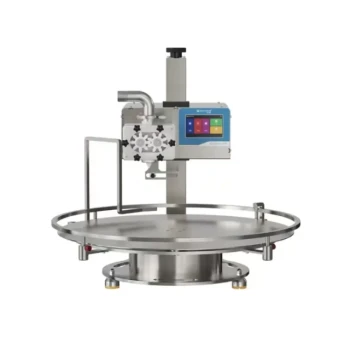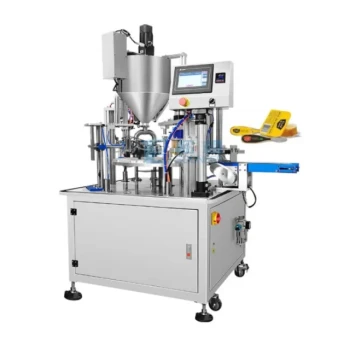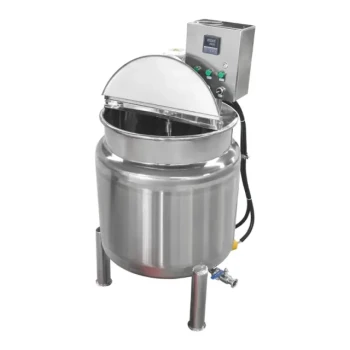At their core, honey filling machines primarily incorporate piston, pump, or gravity-based filling mechanisms to ensure accurate and consistent dispensing. These core systems are often enhanced with supporting technologies like integrated heating elements to manage viscosity and automated capping stations to create a seamless packaging line.
The choice of technology is not about which is "best" overall, but which is best for a specific goal. The decision hinges on a critical balance between the honey's viscosity, the required production speed, and the need for precise, volumetric accuracy.

Core Filling Mechanisms Explained
To select the right machine, you must first understand how the primary filling technologies function. Each is suited for different scales of operation and product characteristics.
Piston Fillers: The Standard for Precision
Piston fillers operate by drawing a precise, predetermined volume of honey into a cylinder and then dispensing it into the container. This method is known as volumetric filling.
Because it measures by volume, it is exceptionally accurate and is the preferred choice for thick, viscous liquids like honey. It minimizes product waste and ensures consistency from one jar to the next.
Pump-Based Systems: The Key to High Volume
Pump-based systems regulate the flow of honey to fill containers, prioritizing speed and throughput. This mechanism is ideal for high-volume, fully automated production lines.
While highly efficient, the accuracy can be slightly less than a piston filler, but it is the go-to technology when speed is the most critical factor in a large-scale commercial operation.
Gravity and Vacuum Fillers: Niche Applications
Gravity fillers rely on the weight of the honey to fill containers and are typically better suited for lower-viscosity liquids. However, they can be adapted for thinner honey varieties.
Vacuum fillers create a vacuum seal on the container, drawing the product in. This can be useful for preventing air bubbles and handling specific container shapes.
Essential Supporting Technologies
Modern honey filling machines are more than just a dispenser. Several integrated technologies are critical to efficiency and product quality.
Heating Mechanisms for Fluidity
Honey's viscosity changes significantly with temperature. Many machines include optional heating elements in the hopper or along the product path.
This gentle heating lowers the honey's viscosity, allowing it to flow smoothly and quickly. This prevents air bubbles and ensures a clean, consistent fill.
Automated Capping and Sealing
For a complete production solution, many filling systems can be integrated with automatic capping or sealing mechanisms. This technology applies and tightens lids immediately after filling.
This automation is crucial for maintaining hygiene and increasing overall production speed, moving from a semi-automated process to a fully integrated line.
Customization for Diverse Packaging
The machine's design must accommodate the final product format. Modern systems offer customization for a wide range of containers.
This includes everything from traditional glass jars and plastic bottles to smaller formats like sachets and single-serving honey sticks.
Understanding the Trade-offs
Selecting a technology involves weighing its advantages against its limitations. No single system excels in every category.
Accuracy vs. Speed
This is the most fundamental trade-off. Piston fillers offer superior accuracy, which is vital for high-value products where every gram counts. Pump-based systems offer superior speed, essential for meeting high production quotas.
Complexity and Cost
A simple, semi-automatic piston filler is a relatively straightforward and cost-effective machine. A fully automated line with pump fillers, heating, and integrated capping is a significantly larger investment in terms of both cost and operational complexity.
Product Integrity
While heating is beneficial for flow, it must be carefully controlled. Excessive heat can degrade the natural enzymes and delicate flavors of raw honey. A quality machine will offer precise temperature controls to protect the product.
Making the Right Choice for Your Operation
Your operational goals should dictate your technology choice.
- If your primary focus is maximum precision for artisanal or high-value honey: A volumetric piston filler is the ideal choice to minimize waste and ensure consistency.
- If your primary focus is high-speed commercial production: An integrated, pump-based system will deliver the throughput necessary for large-scale operations.
- If your primary focus is versatility to handle different honey types: Prioritize a machine with precise and reliable heating controls to manage varying viscosities effectively.
Ultimately, the right technology is the one that aligns directly with your production scale, product type, and business objectives.
Summary Table:
| Technology | Best For | Key Feature |
|---|---|---|
| Piston Filler | Artisanal/High-Value Honey | Superior Volumetric Accuracy |
| Pump-Based System | High-Volume Commercial Production | Maximum Speed & Throughput |
| Gravity/Vacuum Filler | Thinner Honey Varieties | Adaptable for Specific Needs |
| Heating Mechanisms | Managing Viscosity | Ensures Smooth, Consistent Flow |
| Automated Capping | Complete Packaging Lines | Increases Hygiene & Speed |
Ready to optimize your honey packaging line?
At HONESTBEE, we supply the precise beekeeping supplies and equipment that commercial apiaries and distributors need to scale efficiently. Whether your priority is the pinpoint accuracy of a piston filler for high-value products or the high-speed throughput of a pump system for large-scale operations, our wholesale-focused solutions are designed to meet your specific production goals.
We help you protect product integrity while maximizing output. Contact our experts today to discuss the ideal filling technology for your business!
Visual Guide

Related Products
- Economy Small Honey Filling Machine Honey Bottle Filler Packaging Machine
- Small Honey Filling Machine Sachet Packing Equipment Single Nozzle
- Commercial Rotary Honey Filling Machine for Production
- Precision Automated Packaging Turntable Honey Spoon Filling Sealing Packing Machine
- Double Wall Honey Heating Stirring Homogenizer Mixing Machine with Various Capacity
People Also Ask
- What are the different types of filling mechanisms used in honey filling machines? Choose the Right Tech for Your Honey
- What types of machines are used for honey packaging? Build an Efficient Line for Your Scale
- How does a honey filling machine benefit small-scale honey processing businesses? Boost Efficiency & Brand Quality
- How does a VFFS liquid packaging machine handle honey packaging? Master Viscous Liquid Filling
- What features should a machine have to handle honey's viscosity effectively? Ensure Accurate, Clean Filling



















